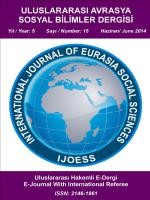SINIF ÖĞRETMENLERİNİN “COĞRAFYA” İMAJLARI
Bu çalışmada ilköğretim sınıf öğretmenlerinin “Coğrafya” disiplini hakkında zihinlerinde oluşturdukları imajlar ortaya çıkarılmaya çalışılmıştır. Bu amaçla çalışmada yarı yapılandırılmış görüşme tekniği kullanılmıştır. Çalışmanın araştırma grubunu 67 ilköğretim öğretmeni oluşturmaktadır. Elde edilen verilere Nvivo 8 aracılığı ile içerik analizi yapılarak temalar ve kodlar belirlenmiştir. Araştırmanın bulgularına göre; “Coğrafya”, fiziki coğrafya konularından ibaret algılanmakta ve “Coğrafya” denilince öncelikle ve çoğunlukla akıllara yeryüzü şekilleri gelmektedir. Buna ek olarak, coğrafi çevre ile insan arasındaki ilişki yeteri kadar kurulamamaktadır. Coğrafi çevre denilince sınırlandırılmış bir alan algılanmaktadır. Coğrafyada kullanılan prensipler yeterli düzeyde bilinmemekte ve coğrafi bilgiler “tanıma” amaçlı olarak gerekli görülmektedir. Araştırmanın sonucu, öğretmenlerin coğrafya imajlarında eksiklik ve yanlışlıklar olduğunu göstermektedir.
Anahtar Kelimeler:
Coğrafya Eğitimi, Sınıf Öğretmeni, İmaj.
CLASS TEACHERS’ IMAGES ABOUT “GEOGRAPHY”
In this study, class teachers’ images about “Geography” which is constructed in the mind is determined. For this aim, , a semi-structured interview technique was used in the study. Group of the research consists of 67 elementary school teachers. In the study, content analysis from the methods of qualitative research (via NVivo 8 programme) have been used during data analyzing. According to findings of the study; teachers see geography only as physical geography, land forms come to their minds firstly and mostly when they hear the word of geography. In addition to this, they are not aware of the relationship between geographical environment and human. When geography is called a limited area are perceived. There is no adequate awareness about the principles of geography and geography knowledge is necessary for “identification”. The result of the study shows the wrongs (lacks) and missings in teachers’ geography image.
Keywords:
Geography Education, Elementary Teacher, Image.,
___
- Alkış, S. (2009). Turkish geography trainee teachers’ perceptions of geography. International Research in Geographical and Environmental Education (IRGEE), 18(2), 123-136. http://www.informaworld.com/smpp/ content~db=all~content=a911910378, erişim tarihi:12.10.2010.
- Akyol, Ç. (2010). Coğrafi Çevre Nedir ? http://www.bilgininadresi.net, Erişim tarihi:11.10.201.
- Boyce R. R. & Clark, W., A., V. (1964). The concept of shape in geography. Geographical Review, Vol. 54, No. 4, pp. 561-572.
- Cassell, C., Buehring, A., Symon, G., Johnson, P. & Bishop, V. (2005). Qualitative management research: A thematic analysis of interviews with stakeholders in the field. ESRC Benchmarking Good Practice In Qualitative Management Research.
- Mark, D. M. & Egenhofer, M.. J. (1994). Calibrating The Meanings Of Spatial Predicates From Natural Language: Line-Region Relations, Proceedings, Spatial Data Handling, Vol. 1, pp. 538-553. http://plone.itc.nl/agile_old/Conference/greece2004/papers/8-1-3_Riedemann.pdf, Erişim tarihi: 11.10.2010.
- Demircioğlu, İ., H. (2004). Tarih ve coğrafya öğretmenlerinin sosyal bilimler öğretiminin amaçlarına yönelik görüşleri. Bilig, 31: 71-84.
- Demircioğlu, İ.,H. (2006). Sosyal bilgiler öğretmen adaylarının sosyal bilimler hakkındaki görüşleri. Bilig, 36: 113-124.
- Duit, R. (1991). On the role of analogies and metaphors in learning science. Science Education, 75(6): 649-672.
- Gabel, D. L., Samuel, K., V. & Hunn, D. (1987). Understanding the particulate nature of matter, J. Chem. Edu., 64: 695-697.
- Higbee, K. L. (1977). Your memory: How it works and how to improve it? New Jersey: Prentice-Hall.
- Holt-Jensen, A. (1980). Geography: Its history and concepts. London: Harper&Row.
- İpek, C. & Bayraktar, F. (2004). Aday öğretmenlerin fen bilimleri ve sosyal bilimlere bakışları. Yüzüncü Yıl Eğitim Fak.Dergisi, I(1). Haziran.
- Karabağ, S. (1998). Coğrafya öğretiminde anahtar sorular ve kavramlar. Gazi Eğitim Fakültesi Dergisi, 18(2), 25-41.
- Karadeniz, Ö., Karadeniz, C., Özdemir, N. (2006). Sosyal bilgiler öğretmen adaylarının coğrafya alanına ilişkin öz yeterlik inançları Ondokuz Mayıs Üniversitesi Eğitim Fakültesi Dergisi, 22: 23-30.
- Kendall, M. H., Glendinning, M. R., M'Fadden, H. C. (1962). Introduction to geography. New York: Hercourt, Brace and World, Inc.
- Kent, A. (2000). Geography’s changing image and status–some international perspectives. Int. Research in Geog. and Env. Edu., 9(2).
- Kuipers, B. (1978). Modeling spatial knowledge. Cognitive Science, 2:129-153.
- Kuipers, B. & Levitt, T. (1988). Navigation and mapping in large-scale space. AIMagazin, 9(2):25-46.
- Lacoste, Y. (2004). Coğrafya savaşmak içindir. Ankara: Doruk Yayıncılık.
- Luria, A. R. (1968). The mind of mnemonist. Harmondsworth: Penguin.
- Oldroyd, D. (1996). İnsan düşüncesinde yerküre. (Çev.: Ülkün Tansel). Ankara: Tübitak Popüler Bilim Kitapları.
- Osborne, R. J. & Gilbert, J.K. (1980). A technique for exploring students’ views of the world. Physics Education, 15: 376-379.
- Ostuni, J. (2005). Geography: The image of an uncomprehended science. Int. Research in Geogr. and Environmental Education, 14(1).
- Özel, A. & Bayındır, N. (2008). Sınıf öğretmenlerinin ve sınıf öğretmeni adaylarının coğrafya konularına yönelik görüşlerinin karşılaştırılması. Millî Eğitim Dergisi, 178.
- Öztürk, M. & Alkış, S. (2009). Sınıf öğretmeni adaylarının coğrafya ile ilgili algılamaları. İlköğretim Online Dergisi, 8(3),782-797. http://ilkogretim-online.org.tr/vol8say3/v8s3m13.pdf , Erişim tarihi:12.10.2010.
- Ronald, R., B. & Clark, W. A. V. (1964). The concept of shape in geography. Geographical Review, 54(4):561- 572.
- Schmudde, T. H. (1987). The image of geography equals the structure of its curriculum and courses. Journal of Geog., 86 (2):46-47.
- Scott Report, (1942). http://www.jstor.org/pss/1790119, erişim tarihi: 11.10.2010.
- Sorre, M. (1943). Les Fondements de la Géographie Humaine, Vol.I:Les FondementsBiologiques :Essai d’une Ecocologie de l' Homme, Librairie Armand Colin, Paris.
- Tanoğlu, A. (1964). Coğrafya Nedir? İ. Ü.Coğr. Enst. Dergisi, 14: 3-14.
- Yıldırım, A. & Şimşek, H. (2005). Sosyal bilimlerde nitel araştırma yöntemleri. Ankara:Seçkin Yayınları.
- Webb, M. J. (1985). Analogies and their limitations. School Science and Mathematics, 85: 645-650.
- Weller, C. M. (1970). The role of analogy in teaching science. J. Res. Sci. Teach., 7:113-119.
- West, B. A. (2006). Conceptions of the ‘role of geography in their futures’ held by senior geography students in one ındependent queensland school. International Research in Geographical and Environmental Education, 15(2).
- White, R.T. & Gunstone, R.F. (1992). Probing understanding. The Falmer Press, London.
- ISSN: 2146-1961
- Başlangıç: 2015
- Yayıncı: Kadir ULUSOY
Sayıdaki Diğer Makaleler
COMPARISION OF KOREAN ESL LEARNERS’ WITH NATIVE SPEAKERS’ APOLOGIES: IMPLICATIONS FOR TEACHERS
İLKÖĞRETİM SOSYAL BİLGİLER 7. SINIF ÖĞRENCİLERİNİN GRAFİK OKUMA BECERİSİNİ KAZANMA DÜZEYLERİ
Şahin ORUÇ, İsmail Hakan AKGÜN
SINIF ÖĞRETMENLERİNİN “COĞRAFYA” İMAJLARI
Ayşegül ŞEYİHOĞLU, Yılmaz GEÇİT
STRATEJİK PLANLAMA UYGULAMALARINA İLİŞKİN İLK VE ORTA ÖĞRETİM OKUL MÜDÜRLERİNİN GÖRÜŞLERİ
